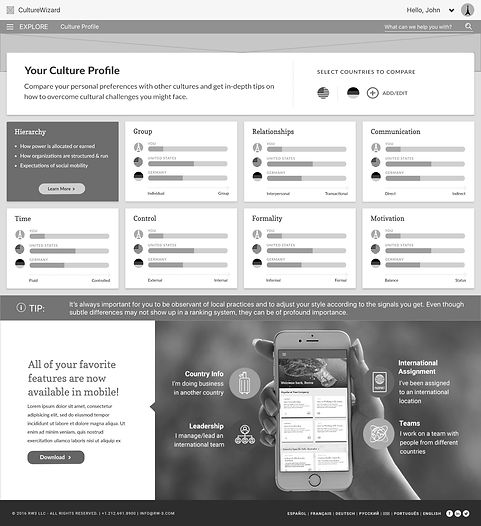
RW-3
Culturewizard
CultureWizard offers a personalized e-learning platform to teach intercultural training for organizations that send their employees abroad. Whenever you're conducting business in a foreign country with different cultural values and norms, it's important to educate yourself on how to communicate and interact effectively with people. Using an online learning format with instructor-led courses and access to a vast multimedia library, CultureWizard helps business professionals master the Global Mindset necessary to succeed in today’s market.
This client came to us with a digital product offering that had compelling, well-written content but lacked a cohesive and modern user experience that consumers have come to expect in the modern era. We were asked to come up with UX and creative recommendations to help modernize their product and make it easier to use.
Client /
RW-3 Culturewizard
Role /
Senior UX Designer
My Role
I was initially tasked with creating a UX audit of their platform to help identify features and components that could be overhauled to deliver the most "bang for buck"--i.e. strong enhancements that would require the least amount of effort from a design and development standpoint. After conducting the audit, the client decided to invest more in the project, so we did a full immersion workshop which I helped lead. Following the workshop, I brainstormed with the team to define our approach for the project. We divided the workload into agile-based design sprints, and I created wireframes and documentation that was presented to the client for approval before the creative team produced high-fidelity comps of the key pages and templates. I annotated the wireframes and comps to convey important notes about how the interconnected elements were designed to behave.
Workshop & Alignment
To start the project, we began with an immersion workshop (as we typically like to do with any project). We came out of the workshop feeling energized because we all felt aligned on the assignment and the key guideposts we would follow in order to accomplish the project goals.
Project Goals:
The main goal was to retain existing clients and appeal to new clients. This could be achieved by:
-
Modernizing the brand
-
Driving engagement through increased ease of use and a better organized system
-
Increasing use across all platforms
Guideposts
-
Even though the current web property is primarily used on desktop, planning for the future means finding strategies to drive mobile usage.
-
Better communicate product benefits in order to drive engagement and help convey value to buyers
-
Competitive products are dull and corporate. Convey emotion, fun and excitement in order to distinguish the brand.
-
Instead of just rewarding completion of courses, appeal to users' deep motivations around self-improvement and empowerment.
-
A highly polished experience and aesthetic will communicate value to buyers and align with the new generation's high expectations.
Diving In
In order to wrap my head around the product as a whole, I started by creating a site map of the existing platform.

Reimagining the Navigation and Nomenclature
A lot of the terminology used on the site was confusing--users didn't have a sense of what content they were going to see when navigating to certain parts of the site, and many of the terms were ambiguous and misleading. We went through an exercise to figure out how we could simplify the language so that the experience was more intuitive. Based on this exercise, we were able to come up with a plan for a new sitemap that was significantly more simple.

Product Strategy Recommendations
We brainstormed and explored all kinds of ideas for how we could best add value to the product moving forward. We began to narrow down our ideas, and I created a summarized list of our strongest recommendations.

Given the constraints of the project in terms of budget, timeline, and scope, we know that not every recommendation would be implemented for launch. I created a feature value matrix to help the client better understand how much value each recommendation would add, and the level of effort for each.

Wireframes
Based on feedback from the client, we knew a simplified navigation structure was crucial. That's where I dedicated the majority of my effort in the first sprint.

Other pages that were important to drill down on in the wireframe stage were the individual country profiles, course landing pages, and culture calculator (a self assessment test for determining your cultural characteristics and traits so that you can compare yourself to the cultures of other countries).



Final Designs & Annotations
We had a great relationship with the client and they provided meaningful feedback at every step of the design process. The final designed output was incredibly strong, and provided the client with a clear roadmap of pages and modules to develop moving forward. Once we had sign off from the client, I provided annotated comps and wireframes to help guide the developers and clear up any questions about the intended functionality.


